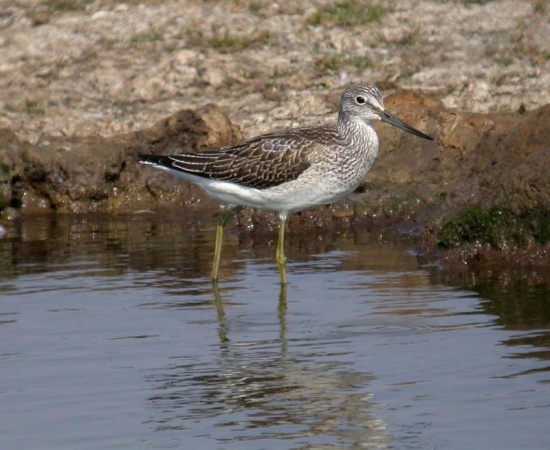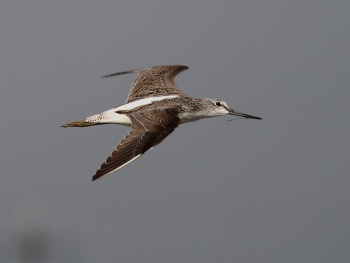
- Tringa nebularia
Identification
- Grey-brown upperparts
- Pale underparts
- Dark grey flecks on head and neck
- Narrow white eye ring
- Dark outer-wing
- White rump and back
- Dark to green-grey long, upward curved bill
- Yellowish-green long legs
Breeding birds
- Bold black chevrons on chest
- Heavily streaked and marked upper body
Distribution
Africa, Coastal Asia, India, the Philippines, southern New Guinea and Australia.
Taxonomy
This is a monotypic species[1].
Subspecies glottoides is not recognised by most authorities[2].
Habitat
Coastal areas and inland, estuaries, mudflats, mangrove swamps, lagoons, swamps, and flooded crops.
Behaviour
Diet
The diet includes insects, worms, molluscs, small fish and crustaceans.
Breeding
The male builds the nest, a shallow depression lined with feathers and vegetation. Both sexes share the incubation and the raising of the young.
Vocalisation
Call: tyew_tyew_tyew
Song: repetitive and persistant clu_wee" delivered in high flight.
References
- Clements, JF. 2010. The Clements Checklist of Birds of the World. 6th ed., with updates to December 2010. Ithaca: Cornell Univ. Press. ISBN 978-0801445019. Spreadsheet available at http://www.birds.cornell.edu/clementschecklist/Clements%206.5.xls/view
- Avibase
- Collins Bird Guide ISBN 0 00 219728
- Birds in Backyards
Recommended Citation
- BirdForum Opus contributors. (2025) Common Greenshank. In: BirdForum, the forum for wild birds and birding. Retrieved 9 May 2025 from https://www.birdforum.net/opus/Common_Greenshank
External Links
GSearch checked for 2020 platform.1




